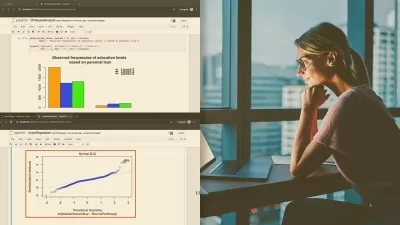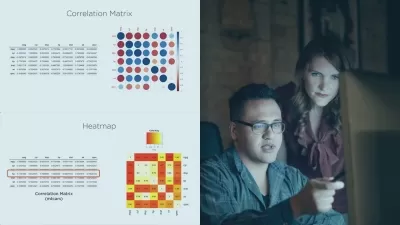Machine Learning 101 with Scikit-learn and StatsModels
365 Careers
5:13:39
Description
New to machine learning? This is the place to start: Linear regression, Logistic regression & Cluster Analysis
What You'll Learn?
- You will gain confidence when working with 2 of the leading ML packages - statsmodels and sklearn
- You will learn how to perform a linear regression
- You will become familiar with the ins and outs of a logistic regression
- You will excel at carrying out cluster analysis (both flat and hierarchical)
- You will learn how to apply your skills to real-life business cases
- You will be able to comprehend the underlying ideas behind ML models
Who is this for?
What You Need to Know?
More details
DescriptionAre you an aspiring data scientist determined to achieve professional success?
Are you ready and willing to master the most valuable skills that will skyrocket your data science career?
Great! You’ve come to the right place.
This course will provide you with the solid Machine Learning knowledge that will help you reach your dream job destination.
That’s right. Machine Learning is one of the fundamental skills you need to become a data scientist. It is the stepping stone that will help you understand deep learning and modern data analysis techniques.
In this course, we will explore the three most fundamental machine learning topics:
Linear regression
Logistic regression
Cluster analysis
Surprised? Even neural networks geeks (like us) can’t help, but admit that it’s these 3 simple methods - linear regression, logistic regression and clustering that data science actually revolves around.
So, in this course, we will make an otherwise complex subject matter easy to understand and apply in practice.
Of course, there is only one way to teach these skills in the context of data science - to accompany statistics theory with practical application of these quantitative methods in Python.
And that’s precisely what we are after. Theory and practice go hand in hand here.
We have developed this course with not one but two machine learning libraries – StatsModels and sklearn. As our practical experience showed us, they have different use cases and should be used together rather than independently.
Yet another advantage of taking this course? We are very conscious that data science theory is often overlooked.You can’t teach someone to run before they know how to walk. That’s why we will start slowly and continue by building complex ML models.
But don’t assume you’ll be bored by theory.
On the contrary! We have prepared a course that will get you results and will foster your interest in the subject matter, as it will show you that machine learning is something you can do, too (with the right teacher by your side).
Well, we hope you are as excited as we are, as this course is the door that can open countless opportunities in the data science world for you. This is a course you’ll be actually eager to complete.
On top of that we are happy to offer a 30-day money back guarantee. No risk for you. The content of the course is so outstanding , that this is a no-brainer for us We are 100% certain you will love it.
Why wait any longer? Every day is a missed opportunity.
Click the “Buy Now†button and let’s start (machine) learning together!
Who this course is for:
- This course is for you, if you want to become a successful data scientist
- This course is great if you want to get acquainted with the fundamental machine learning methods
- This course is ideal for you, if you are a just getting started and want to gradually build up valuable skills in machine learning and data science
Are you an aspiring data scientist determined to achieve professional success?
Are you ready and willing to master the most valuable skills that will skyrocket your data science career?
Great! You’ve come to the right place.
This course will provide you with the solid Machine Learning knowledge that will help you reach your dream job destination.
That’s right. Machine Learning is one of the fundamental skills you need to become a data scientist. It is the stepping stone that will help you understand deep learning and modern data analysis techniques.
In this course, we will explore the three most fundamental machine learning topics:
Linear regression
Logistic regression
Cluster analysis
Surprised? Even neural networks geeks (like us) can’t help, but admit that it’s these 3 simple methods - linear regression, logistic regression and clustering that data science actually revolves around.
So, in this course, we will make an otherwise complex subject matter easy to understand and apply in practice.
Of course, there is only one way to teach these skills in the context of data science - to accompany statistics theory with practical application of these quantitative methods in Python.
And that’s precisely what we are after. Theory and practice go hand in hand here.
We have developed this course with not one but two machine learning libraries – StatsModels and sklearn. As our practical experience showed us, they have different use cases and should be used together rather than independently.
Yet another advantage of taking this course? We are very conscious that data science theory is often overlooked.You can’t teach someone to run before they know how to walk. That’s why we will start slowly and continue by building complex ML models.
But don’t assume you’ll be bored by theory.
On the contrary! We have prepared a course that will get you results and will foster your interest in the subject matter, as it will show you that machine learning is something you can do, too (with the right teacher by your side).
Well, we hope you are as excited as we are, as this course is the door that can open countless opportunities in the data science world for you. This is a course you’ll be actually eager to complete.
On top of that we are happy to offer a 30-day money back guarantee. No risk for you. The content of the course is so outstanding , that this is a no-brainer for us We are 100% certain you will love it.
Why wait any longer? Every day is a missed opportunity.
Click the “Buy Now†button and let’s start (machine) learning together!
Who this course is for:
- This course is for you, if you want to become a successful data scientist
- This course is great if you want to get acquainted with the fundamental machine learning methods
- This course is ideal for you, if you are a just getting started and want to gradually build up valuable skills in machine learning and data science
User Reviews
Rating
365 Careers
Instructor's Courses
Udemy
View courses Udemy- language english
- Training sessions 75
- duration 5:13:39
- English subtitles has
- Release Date 2023/09/04











